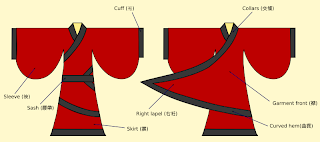I'll do a quick history talk regarding to the lost clothing I am doing, and why most people today pecieve traditional Chinese clothing the way it is. Ming dynasty is the last ethnic Han Chinese dynasty in history, in 1644, the Manchu or formally called Jurchens in the North successfully taken over Beijing.
What happened was, in 1644, they imposed the queue order upon the Han Chinese. Basically, the Chinese must shave off all of their hair (which culturally the Chinese take strong value in) and leave a tiny coin size spot in the back of their head and grow a pig tail out from that spot. The three heads on the right shows the evolutionary change throughout time. The bottom pretty much resembles what we see in the Chinese railway workers in North America in the beginning of the last century.
Before 1644, this has always been the clothing that the Han Chinese wear. It's true that different dynasties throughout China established it's own unique style of clothing, but the basic format stayed the same throughout the past 3000 years, and it was a natural development throughout the way.
This is the Manchu clothing, it was later forced upon the Han Chinese (men originally). Today, what's commonly perceived as traditional Chinese clothing are modified based on these clothes.
Just to show some photos to prove that I am not lying ;p
So basically, the queue resembles a submission to the Tartar Rule. In reality, it's not just about submission, it's more of a symbol of slavery.
This is a painting of Matteo Ricci, an Italian Missionary who came to China in the late 16th century. This painting done that time clearly revealed the clothing of the original Hans.
Thursday, September 23, 2010
2
The Design Proposal and Brief I did from the handouts (from Sharon Romero before Summer 2010) during the summer, this gives a clearer idea of what I had originally before taking feedback at school.
1
The last Chinese line says "any sort of cultural inheritance need a certain degree of ceremonial rites"
Subscribe to:
Comments (Atom)











